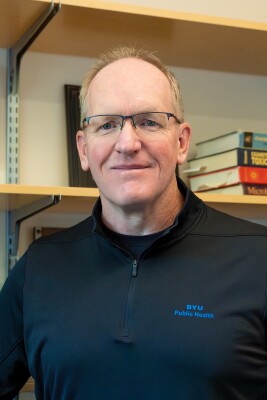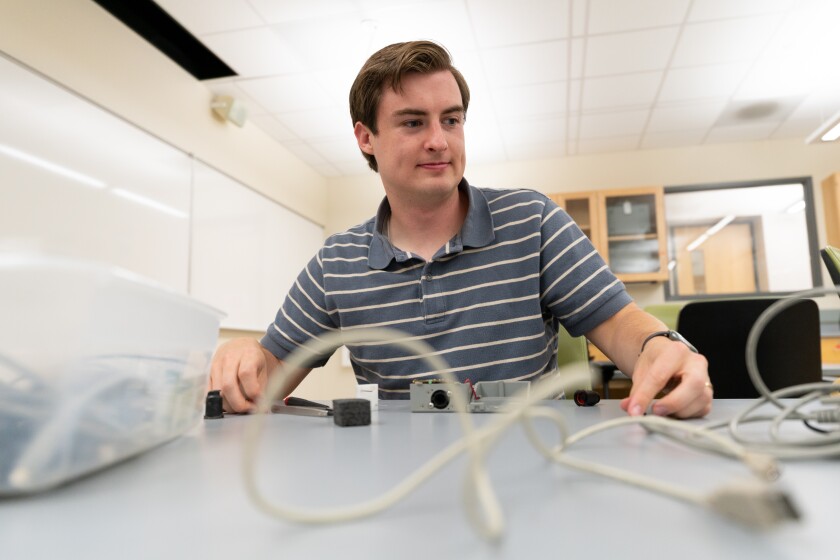
Homes are often considered safe spaces from environmental harm, but sometimes tiny pollutants can get in. The worst part? You probably don’t notice the long-term negative effects these molecules can have on your health. Indoor air quality and these problematic particles are the constant concern of Environmental and Occupational Health (EOH) researchers, who dedicate their lives to ensuring environments are safe for humans wherever they live or work.
BYU’s own EOH Lab provides opportunities for students to help solve these public health issues. The lab is split between three professors: Dr. Jim Johnston, Dr. Steve Thygerson, and Dr. John Beard. Each professor brings their unique expertise to give students a complete EOH experience. Students can study under one or all three professors depending on their research interests.
Johnston focuses his research on the indoor environmental quality of homes and schools throughout Utah and the world. Homes provide a protective shield from outdoor air pollution, but some pollutants can still enter the home, and not all homes are created equal. Evaporative coolers, for example, pull large amounts of outdoor air into the home without effectively removing gas and particle-phase air pollutants. While evaporative coolers are cheaper than central air conditioning units, they can bring bioaerosols like endotoxins and beta-glucans from bacteria and mold into the home. Early life exposures to bioaerosols such as endotoxins are important for healthy immune development, but can be problematic for older children and adults who have asthma or other allergic diseases.

Johnston’s research also explores housing factors in Nepal that contribute to brick workers’ overall daily pollution exposures. Brick workers globally are exposed to high levels of pollution and dust during work, and high levels of pollution in their homes during non-working hours. The goal of this research is to find sustainable ways to improve indoor air quality in their housing so workers will have several hours per day of relief from inhaling air pollution.
Students in this lab gain hands-on experience operating various types of portable air monitors both inside and outside homes. These monitors are used to sample gas and particle-phase pollutants. Students learn how to interpret sampling results in the context of existing air quality policies and standards. As an example, Johnston and his team recently finished monitoring 31 homes in Utah County, a feat they have accomplished over the last two summers, to evaluate the amount of ozone and PM2.5 that infiltrate into homes, depending on the type of air conditioner being used. Both ozone and PM2.5 are criteria air pollutants that have important health effects, and this study makes an important addition to the literature on residential pollution exposure.

Johnston has also researched radon levels in Utah schools. Radon is a harmful radioactive gas that enters buildings through the surrounding soil. In the U.S. and globally, radon is the second leading cause of lung cancer, after smoking. Radon gas is colorless and odorless, and the only way to know if it is present in your home or workplace is to test for it. Johnston has worked closely with Beard and their students to test K-12 schools in a number of rural areas in Utah. Johnston is part of a BYU team working on methods to decrease radon levels in schools in Utah.
With the heavy wildfires last summer, Johnston has also started to research how much smoke enters homes during days with the largest fires. He surveyed a number of different home types to see which are more protective.

Johnston loves getting to see the students grow through the research. “It's been really rewarding to work with students and empower them to problem solve with all that goes into pulling off a research study, and then seeing the end result,” shared Johnston. “When you get to the point where you're publishing data and students are presenting at conferences, you see them progress through that research process and come to a greater understanding of it. It's fun, as a professor, and it's a privilege.”
Sofia Reyes Guerrero (PH, ’25) has worked on the radon projects in the EOH Lab and has learned a lot about the industry in a short amount of time. She enjoys the one-on-one guidance within the emphasis thanks to its smaller enrollment size.
The major and lab environment is a perfect fit for Guerrero because it blends STEM and people skills. “I love STEM, but I didn't really like that it was more about solving problems and making formulas. I felt like I needed more interaction,” Guerrero shares. “I really liked that about the lab; the part of helping someone but you have to also know what we can do to prevent an issue, or if something bad is going on, what we can do to stop it.”

Johnston tries to model a Christ-centered life while students are in the lab, even in tough times. “We've had challenges on our trips to Nepal before where we prayed for help,” reflected Johnston. “We have seen God’s hand in our travels, usually through the generosity and kindness of others.” Students are encouraged to seek divine inspiration in their work, and to actively look for opportunities to reflect God’s love for his children in their interactions with others. He also takes every opportunity he can to share his testimony with his students.
The Johnston lab has been graciously funded through a variety of sources. Projects have been supported by the National Institute for Occupational Safety & Health (NIOSH) and the Utah Department of Environmental Quality. Additionally, the Johnston lab has received Interdisciplinary Research (IDR) funding from BYU, a Grants on the Edge award from the College of Life Sciences, Experiential Learning Grants from the Public Health Department, and funding from the Roger and Victoria Sant Endowment and the Charles Redd Center for Western Studies. This funding has helped cover the cost of research equipment and student wages, and has enabled students to travel with Johnston to conduct research in Utah and Nepal.
To get involved with Dr. Johnston’s lab, email james_johnston@byu.edu.
10
Students gain the following skills in the lab:
- How to calibrate, operate, and maintain air sampling equipment
- How to collect data in the field.
- How to weigh air sampling filters.
- They are interested in air quality or EOH issues.
- They are a freshman or sophomore who plans on working in the lab throughout their undergraduate studies.